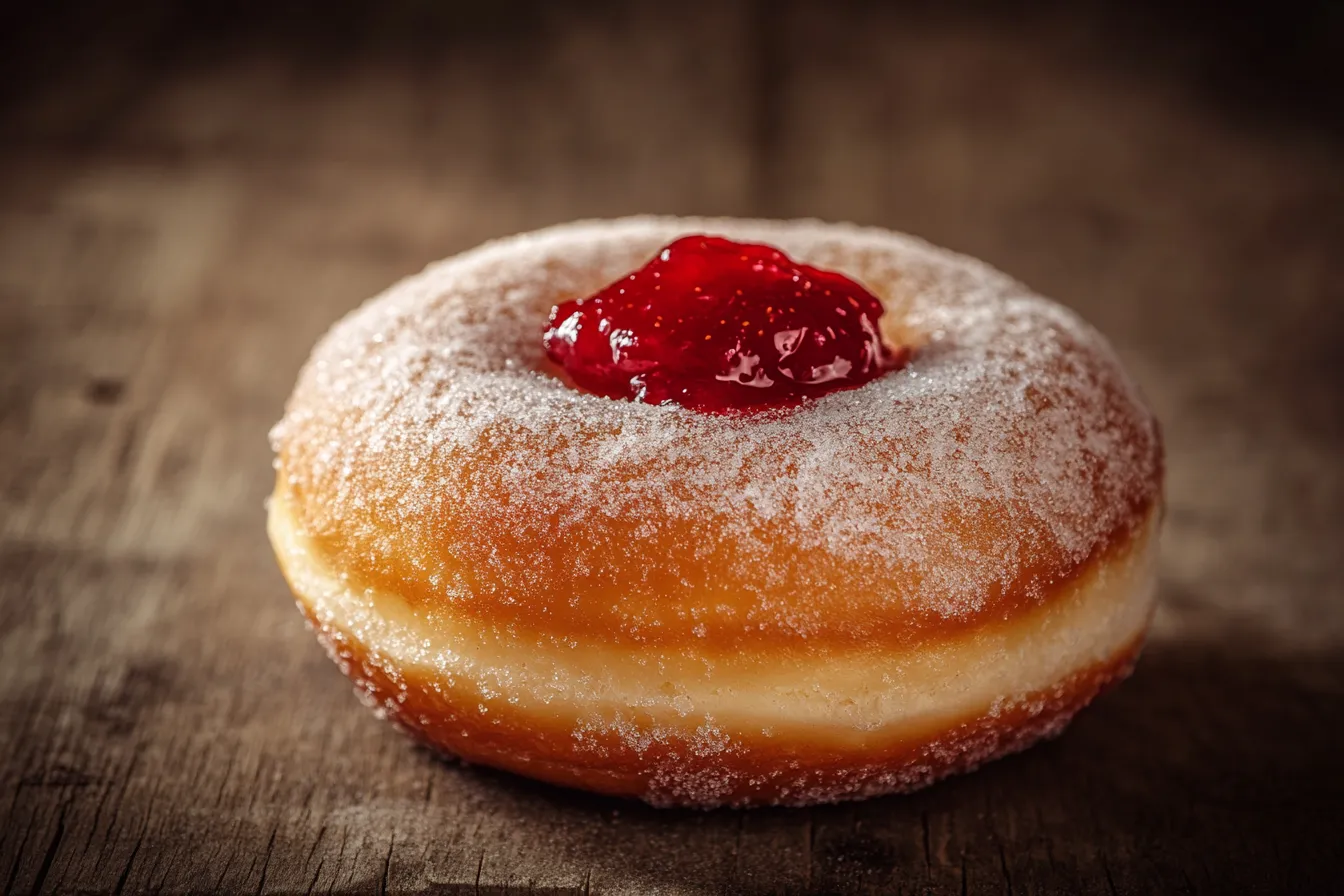Introduction
There’s nothing quite as comforting as biting into a fluffy, jam-filled donut, and among the many donut varieties, the Bismarck donut stands out as a true classic. Loved across North America and Europe, this delightful treat goes by many names — Berliner, jelly-filled, or simply Bismarck — but no matter what you call it, the appeal is universal. Soft, pillowy dough, a generous filling of fruit jam or custard, and a dusting of sugar combine to create a memorable bite that has been adored for generations.
In this in-depth guide, you’ll discover exactly what makes the Bismarck donut so special, its fascinating history, how it differs from other filled donuts, and even how to make it yourself at home. Whether you’re a dedicated foodie or simply curious about trying new pastries, this article will walk you through everything you need to know about the Bismarck donut..Mini Donuts
What is a Bismarck Donut?
The History of Bismarck Donuts
The Bismarck donut traces its roots back to Europe, where jam-filled yeast pastries have been popular for centuries. In Germany, they are traditionally known as Berliner Pfannkuchen, named after the city of Berlin, and were often made for special occasions or during carnival seasons. As German immigrants brought their baking traditions to North America in the 19th and 20th centuries, the Berliner evolved into what many Canadians and Americans now call the Bismarck.
The name “Bismarck” itself is thought to honor Otto von Bismarck, the first chancellor of the German Empire, who was famous in the late 1800s. According to food historians, Bismarck donuts became popular in bakeries across the American Midwest and Canada, where German immigrant communities settled and adapted the recipes to local tastes.
Variations Across Cultures
What’s truly amazing about the Bismarck donut is its ability to adapt across cultures. In Poland, a very similar pastry is called pączki, traditionally eaten before Lent. In Israel, a comparable filled donut called sufganiyah is served during Hanukkah. Each region gives the donut its own twist:
- In Germany, they use plum jam or rosehip preserves.
- In the United States, raspberry or strawberry jelly is more common.
- In Canada, some Bismarcks are filled with custard or even whipped cream.
These subtle differences show how a simple yeast-raised donut can be transformed to reflect local flavors and holiday traditions..Boston Kreme Dunkin Donut Guide You’ll Love
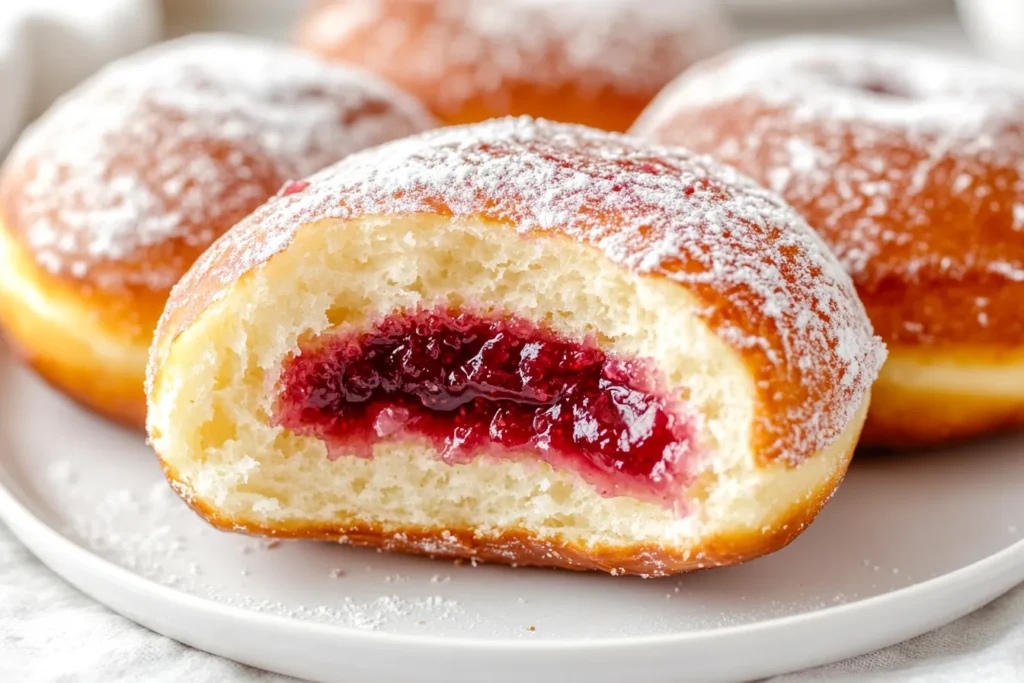
Ingredients and How Bismarck Donuts are Made
The Dough
At the heart of any great Bismarck donut is its yeast dough. Unlike cake donuts, Bismarcks rely on a yeast-based, enriched dough, meaning it contains eggs, butter, and sometimes milk. This gives them a richer, softer texture that holds up beautifully to deep-frying and filling.
The dough is usually proofed twice to achieve its light and airy consistency: once after mixing and again after shaping. This double rise is critical for creating the classic fluffy bite that people associate with Bismarck donuts.
Traditional Fillings
Traditionally, Bismarck donuts are filled with red fruit jams like raspberry or strawberry. Some recipes call for apricot or plum preserves, which offer a slightly tart balance to the sweet dough. The filling is piped in after frying, ensuring the donut stays light and airy rather than soggy.
Sprinkled with powdered sugar or glazed with a light icing, these donuts are a feast for both the eyes and the taste buds.
Modern Twists
In recent years, bakers have experimented with fillings beyond traditional jams. Custard, chocolate cream, and even Nutella have made their way into Bismarck donuts, delighting a new generation of donut lovers. Creative toppings — from cinnamon sugar to matcha glaze — add even more excitement.
Some artisanal donut shops even play with savory versions, filling Bismarcks with cream cheese, lemon curd, or pastry cream infused with spices. These innovations keep the Bismarck relevant in a constantly evolving food culture.
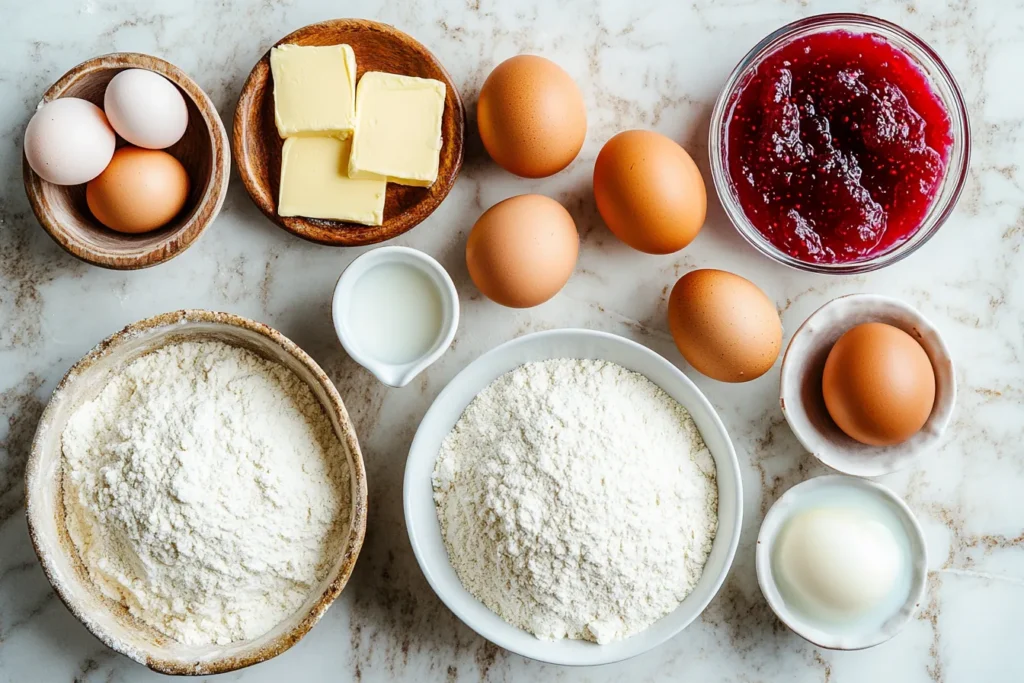
Why Bismarck Donuts Are So Popular
Flavor Profile
There’s a reason the Bismarck donut has captured the hearts of donut lovers worldwide. Its winning flavor profile is built on contrast — the rich, buttery dough paired with a sweet, fruity or creamy filling makes every bite a joy. The yeast dough offers a subtle sweetness and a light, bouncy texture, while the filling provides a burst of flavor, whether it’s raspberry jam, vanilla custard, or chocolate cream.
Add to this the dusting of powdered sugar or a shiny glaze, and the result is a treat that looks as good as it tastes. The flavor combination is satisfying without being overly heavy, making Bismarck donuts perfect for breakfast, dessert, or an afternoon snack.
Textural Appeal
Texture is another key reason Bismarck donuts are so beloved. Unlike dense cake donuts, the yeast-raised dough is airy and soft, with a golden-brown exterior that offers a gentle crispness. When you bite into a Bismarck, you experience a tender, fluffy center that contrasts beautifully with the creamy or jammy filling.
This layered texture — light dough, smooth filling, and sugary topping — gives Bismarck donuts a complex mouthfeel that keeps people coming back for more. For many, it’s a nostalgic experience that brings back childhood memories of bakery trips or weekend treats.
Where to Find the Best Bismarck Donuts
Local Bakeries
If you want to taste a truly authentic Bismarck donut, your best bet is a local bakery with a strong tradition of yeast-raised pastries. Many European-style bakeries, especially those with German or Polish roots, still make Bismarcks using traditional methods. These shops often use high-quality jam and carefully proofed dough, delivering a product that’s light, airy, and bursting with flavor.
In big cities, you might find local bakeries advertising them under other names like “Berliner” or “jelly-filled.” Ask your baker — you might discover an authentic recipe passed down for generations.
Chain Donut Shops
Some popular chains also carry Bismarck-style donuts, although they may go by different names, like “jelly donuts” or “filled donuts.” While these mass-produced versions might lack the handmade touch of local bakeries, they still satisfy a sweet tooth, especially if you’re craving a quick treat on the go.
Always check for freshness, as the best Bismarck donuts are fluffy and tender, not dense or greasy.
Homemade Bismarck Donuts
If you love baking, you can absolutely make Bismarck donuts at home. Homemade versions let you control the quality of ingredients, the amount of filling, and even experiment with your own flavors. There’s something incredibly satisfying about frying up a batch of golden donuts and piping them with your favorite jam or cream.
Plus, you can tailor the recipe to your taste — a lighter glaze, a richer custard, or even dairy-free options. Many home bakers love trying seasonal fillings like apple butter in the fall or lemon curd in the spring, giving a fresh spin to this classic treat.
If you’re interested in exploring the science of yeast dough, check out this excellent resource from Serious Eats for deeper insights into what makes yeast-raised donuts so unique.
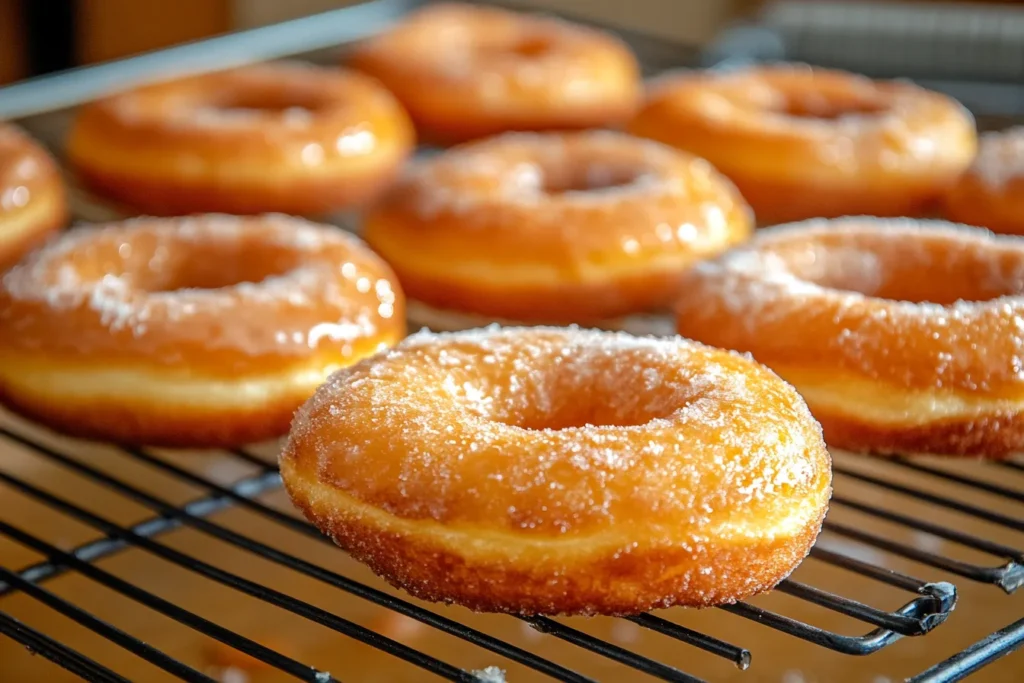
How to Make Bismarck Donuts at Home
Step-by-Step Guide
If you’d like to make your own Bismarck donuts, here’s a simple overview to get you started:
- Make the dough. Use a yeast-based enriched dough with eggs, butter, and milk. Let it rise until doubled.
- Shape the donuts. Roll out and cut rounds using a biscuit cutter, then let them rise again on parchment.
- Fry the donuts. Heat oil to 350°F and fry until golden brown, flipping halfway through.
- Fill them. Let the donuts cool slightly, then inject jam or custard with a piping bag.
- Finish. Dust with powdered sugar or glaze while still slightly warm.
Pro Baking Tips
- Keep your oil temperature steady to avoid greasy donuts.
- Don’t overfill the donuts, or they may split.
- If you’re new to yeast dough, allow enough proofing time for the fluffiest result.
- Use high-quality preserves for the best flavor.
Making Bismarck donuts at home can be a rewarding baking adventure, giving you a bakery-quality treat right from your own kitchen.
Health Considerations of Eating Bismarck Donuts
Nutritional Facts
While the Bismarck donut is undeniably delicious, it’s important to be mindful of its nutritional profile. Like most yeast-raised donuts, Bismarcks are deep-fried, which adds a significant amount of calories and fat. A typical jam-filled Bismarck can range from 250 to 400 calories per piece, depending on its size and filling. Sugar content is also high, thanks to the jam or custard, as well as the powdered sugar or glaze on top.
In terms of macronutrients, a Bismarck donut usually provides a mix of carbohydrates from the flour and sugar, fats from the frying oil and butter, and a small amount of protein from eggs and milk in the dough. If you are watching your diet or limiting your sugar intake, it’s wise to treat Bismarck donuts as an occasional indulgence rather than an everyday snack.
Moderation Tips
You don’t have to completely avoid Bismarck donuts to stay healthy. Here are some moderation tips:
- Share with a friend. Splitting a donut can cut calories in half.
- Balance your day. If you enjoy a donut for breakfast, choose a lighter lunch with protein and vegetables.
- Make them at home. By controlling the ingredients and frying oil, you can create a lighter version with less sugar or even bake them instead of frying.
- Enjoy mindfully. Eating slowly and savoring every bite helps you feel satisfied without overindulging.
Remember, food is meant to be enjoyed — it’s all about balance.
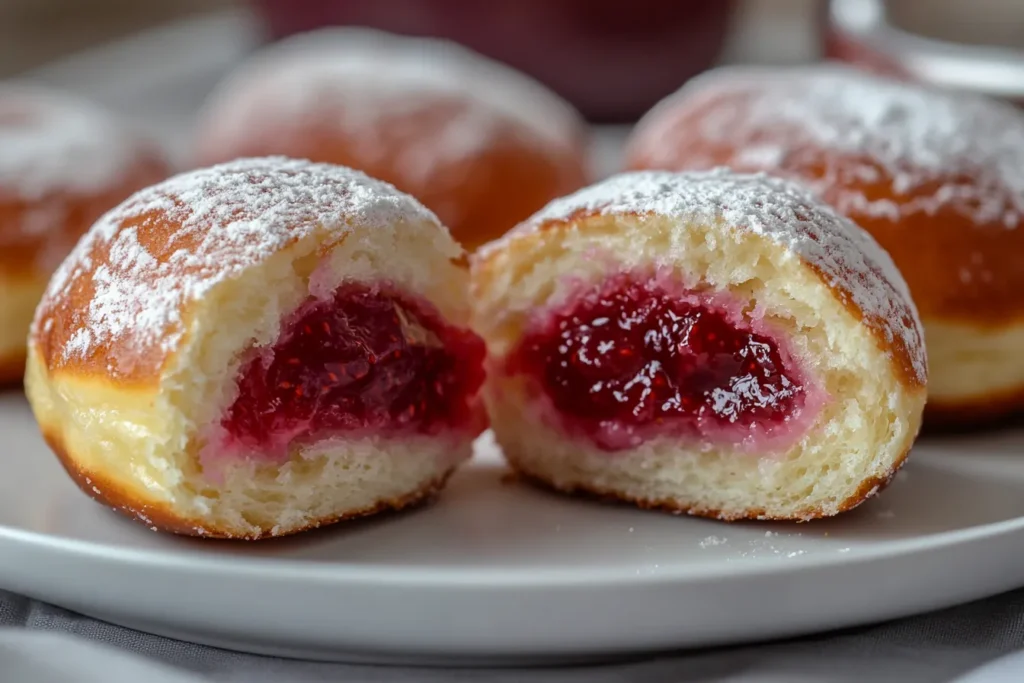
Fun Facts About Bismarck Donuts
Regional Names
Did you know that the Bismarck donut goes by many different names around the world? Here are a few fascinating examples:
- Berliner (Germany): The original name for jam-filled yeast donuts.
- Pączki (Poland): A popular Fat Tuesday treat.
- Sufganiyah (Israel): Traditionally eaten during Hanukkah.
- Krapfen (Austria): Often filled with apricot jam and dusted with sugar.
Though the fillings and toppings may vary, the heart of the donut — a soft, yeasted dough with a sweet center — remains the same.
Historical Tidbits
There’s a fun rumor about Bismarck donuts and Otto von Bismarck, the 19th-century German statesman. According to legend, he was such a fan of these jam-filled pastries that German bakers named them in his honor. While there’s no hard proof of this, the name stuck, and now “Bismarck” is a beloved term for this style of donut in many parts of North America.
The Bismarck donut is also a star of carnival celebrations in many European countries, where fried pastries are traditionally eaten to use up rich ingredients before fasting periods like Lent. That celebratory heritage gives the Bismarck a special place on holiday menus even today.
If you’d like to explore more about the cultural roots of donuts around the world, the National Geographic cultural food traditions page is a fantastic starting point.

FAQ
What makes a Bismarck donut different from a jelly donut?
Technically, a jelly donut is a broad category, while the Bismarck is a specific style of jelly donut traditionally made with yeast dough and filled after frying. The names are often used interchangeably, but “Bismarck” usually signals a European-style filling, like raspberry or plum jam, and a powdered sugar coating.
Can you freeze Bismarck donuts?
Yes, you can freeze Bismarck donuts, though it’s best to freeze them unfilled to preserve texture. Wrap them tightly in plastic wrap, place in an airtight container, and freeze for up to two months. When ready to eat, thaw at room temperature and warm slightly before piping in the filling.
What are the best fillings for Bismarck donuts?
Classic raspberry jam is a time-tested winner, but other delicious fillings include strawberry preserves, lemon curd, Bavarian cream, chocolate hazelnut spread, or even apple butter for a fall twist.
Are Bismarck donuts vegan-friendly?
Traditional Bismarck donuts are not vegan, since they typically contain eggs, milk, and butter. However, you can experiment with vegan dough alternatives using plant-based milk, vegan butter, and egg substitutes.
How did Bismarck donuts get their name?
They are believed to be named after Otto von Bismarck, the famous German chancellor, though the story is partly folklore. German immigrants carried the name to North America, where it stuck.
What’s the difference between a Berliner and a Bismarck?
In Germany, “Berliner” is the proper name for these filled donuts, while in the U.S. and Canada, “Bismarck” is more common. Essentially, they are the same style of yeast donut with a fruity or creamy filling, just known by different names.
Conclusion
Bismarck donuts are more than just a delicious treat — they are a symbol of culinary tradition, cultural history, and the joy of sweet, yeasted pastries shared among friends and family. Whether you call them Berliners, pączki, or sufganiyot, the Bismarck donut’s universal appeal crosses borders and generations.
From its airy, fluffy dough to the vibrant jam or custard fillings, the Bismarck has maintained a devoted fan base for decades. It blends the comforting flavors of sugar, butter, and fruit with a texture that is both light and satisfyingly rich. Beyond its flavor, the Bismarck donut tells a story of migration and adaptation — from German bakers bringing their Berliner traditions to North America, to modern donut shops experimenting with new, creative fillings and toppings.
If you’ve never tried a Bismarck before, now is the perfect time to explore this pastry. Visit a local bakery with European roots, check out a chain donut shop, or even try making your own at home with your choice of fillings. You might discover a new favorite that you’ll look forward to sharing with family and friends.

Name: Bismarck Donut
Ingredients
Equipment
Method
- Instructions:
- In a small bowl, dissolve yeast in the warm milk and let sit for 5 minutes until foamy.
- In a stand mixer bowl, combine flour, sugar, salt, eggs, vanilla, and softened butter. Add the yeast mixture and knead until a smooth dough forms, about 5–7 minutes.
- Cover the bowl with a towel and let the dough rise until doubled, about 1–2 hours.
- Punch down the dough, roll out to about 1/2 inch thick, and cut rounds with a donut cutter or biscuit cutter.
- Place on a lined baking sheet and let rise again for 30–45 minutes until puffy.
- Heat oil to 350°F (175°C) in a deep fryer or large pot.
- Fry each donut for about 1–2 minutes per side until golden brown.
- Drain on a cooling rack lined with paper towels.
- Once slightly cooled, fill with jam using a piping bag.
- Dust with powdered sugar and serve warm.

